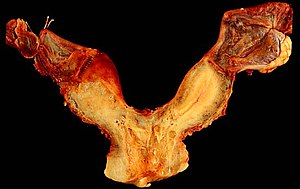Bicornuate uterus
| Bicornuate uterus | |
|---|---|
 |
|
| A human bicornuate uterus | |
| Classification and external resources | |
| Specialty | medical genetics |
| ICD-10 | Q51.3 |
| ICD-9-CM | 752.34 |
| DiseasesDB | 33376 |
A bicornuate uterus or bicornate uterus (from the Latin cornū, meaning "horn"), commonly referred to as a "heart-shaped" uterus, is a uterus composed of two "horns" separated by a septum. In humans, a bicornuate uterus is a type of uterine malformation, but in some other mammalian species, including rodents and pigs, it is normal.
A bicornuate uterus is formed during embryogenesis. The fusion process of the upper part of the paramesonephric ducts is altered. As a result, the lower part of the uterus is unitary while the upper part is bifurcated.
It is possible to diagnose a bicornuate uterus using gynecologic ultrasonography, specifically sonohysterography, and MRI. However, as there is no indication to do such procedures on asymptomatic women, the presence of a bicornuate uterus may not be detected until pregnancy or delivery. In a C-section (usually done due to malpresentation), the irregular shape of the uterus will be apparent.
Other less reliable diagnostic imaging methods include hysterosalpingography and hysteroscopy; these procedures are typically done during the course of an infertility investigation.
Usually bicornuate uterus has good reproductive outcomes. Therefore, the pure type rarely require treatment. In case of hybrid types hysteroscopic metroplasty is needed.
There are many degrees of a bicornuate uterus. There is a continuous range of the degree and location of the fusion of the paramesonephric ducts, and existence of a spectrum, rather than a fixed number of types corresponding to strict medical definitions. Two processes that occur during the embryonic development of the paramesonephric ducts — fusion and reabsorption — can be affected to different degrees. This degree of fusion and reabsorption can determine the likeliness of a pregnancy reaching full term.
There is also a hybrid bicornuate uterus: External fundal depressions of variable depths associated with a septate uterus can be seen by laparoscopy, indicating the coexistence of the two anomalies. These cases are candidates for hysteroscopic metroplasty under appropriate sonographic and/or laparoscopic monitoring.
...
Wikipedia
